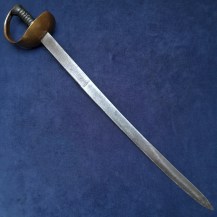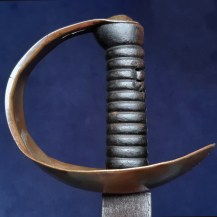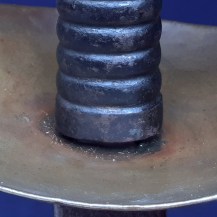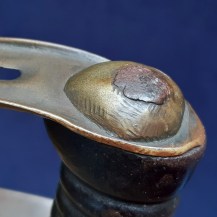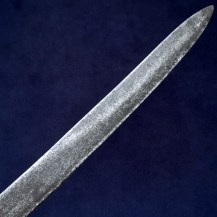British 1845 Pattern Naval Cutlass with Brass Hilt
Slightly curved, unfullered spear pointed blade, brass bowl hilt with turned-over edges and sword knot slit, cast iron ribbed grip, brass teardrop shaped pommel cap. No scabbard. Blade 28 3/8 inches in length, 1/8 inch thick at the shoulder, the cutlass 34 inches overall.
Experiments during the early 1840s for a new naval cutlass design to replace the venerable 1804 Pattern resulted in a design by George Lovell, the Inspector of Small Arms, being accepted in 1842. A fire at the Tower of London destroyed early stocks and the design did not enter service in bulk until three years later, hence being termed the 1845 Pattern. It was considered very successful, handling well compared to its bulky predecessor the 1804 Pattern and being simpler to manufacture.
Being a clone of the 1845 Pattern but with a brass hilt and an entirely unmarked blade, this is almost certainly a commercially produced version intended for sale to merchant shipping or export.
There is a number on the hilt next to the base of the blade in white paint, partly rubbed and probably not antique, perhaps an old collection number – the digits ‘27’ are visible.
May and Annis state quite conclusively in Swords for Sea Service (Vol. 1 p.92) that with regard to British cutlasses: “It is possible that unmarked blades may still be naval but it is more likely that they were made for foreign navies or for civilian use. This would also account for cutlasses sometimes found with brass guards, for brass guards were never used in the Royal Navy.”
Like other swords of the period it has a low carbon tang and shoulder, forge welded to a higher carbon steel blade, and the differential aging of the two materials can be seen clearly at the transition point. The two pieces were chamfered to increase the surface area of the weld: one can see the diagonal line of the weld on the spine and the iron surface extends further up the blade on the right face than the left (roughly 7¾ inches vs 6¾ inches).
The blade has some patination overall, has been sharpened and has some nicks to its edge. The tip of the blade is rounded, worn down by about 2mm. The brass hilt is patinated with some scratches and light dents. The cast iron grip has some light handling wear to its surface and three slit-like holes on one side in the channels between the ‘ribs’, which go through to the hollow interior of the grip. These I think are probably casting flaws. The brass hilt has a curvature to its top face that is a little more extreme than that of the military model, this seems to have produced a gap between the inside of the hilt and the ferrule, and a small gap at the shoulder of the blade on the spine side. The hilt can shift slightly side to side with pressure but the blade and grip are well peened together making the cutlass firm in the hand.


